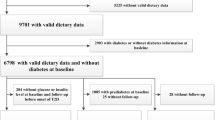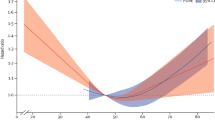Abstract
The aim of this study was to obtain preliminary data to test the hypothesis that (1) a 12-week intervention with 28 g/day of walnuts improves endothelial function in people with type 2 diabetes mellitus (DM) and (2) intake of walnuts improves plasma adipokines after 12 weeks of intervention. In this pilot randomized, single-blinded, controlled trial of 26 adult subjects with prevalent DM, each subject was randomized to a usual diet with 28 g of walnuts per day or usual diet without walnuts (control group). Reactive hyperemia index (RHI), a measure of endothelial function, was measured non-invasively at baseline and after 12 weeks using Endo-PAT2000. We used linear regression to examine the effects of the intervention on RHI. The mean age at baseline was 64.8 ± 11.6 years; 61.5 % of participants were female, and 15.4 % had coronary artery disease. The standard error of RHI was 0.19. The difference in change in RHI during the intervention between the two groups was −0.029 (95 % confidence interval (CI) −0.52, 0.46, p = 0.23). Walnut intervention led to a suggestive increase in adiponectin, albeit non-statistically significant (difference 0.50 μg/ml (95 % CI −0.10, 1.09), p = 0.65). We demonstrated the feasibility of the proposed randomized trial and obtained needed standard deviations to calculate the required sample size to test proposed hypotheses in an efficacy trial.

Similar content being viewed by others
References
Papers of particular interest, published recently, have been highlighted as: • Of importance •• Of major importance
Wirehn AB, Andersson A, Ostgren CJ, Carstensen J. Age-specific direct healthcare costs attributable to diabetes in a Swedish population: a register-based analysis. Diabet Med. 2008;25:732–7.
Marchant K. Diabetes and chronic kidney disease: a complex combination. Br J Nurs. 2008;17:356–61.
Vijan S, Hofer TP, Hayward RA. Cost-utility analysis of screening intervals for diabetic retinopathy in patients with type 2 diabetes mellitus. JAMA. 2000;283:889–96.
Huang ES, Basu A, O’Grady M, Capretta JC. Projecting the future diabetes population size and related costs for the U.S. Diabetes Care. 2009;32:2225–9.
Mozaffarian D, Benjamin EJ, Go AS, Arnett DK, Blaha MJ, Cushman M, et al. Heart disease and stroke statistics—2015 update: a report from the American Heart Association. Circulation. 2015;131:e29–e322.
Hshieh TT, Petrone AB, Gaziano JM, Djousse L. Nut consumption and risk of mortality in the Physicians’ Health Study. Am J Clin Nutr. 2015;101:407–12. This prospective cohort showed that nut consumption is associated with a lower risk of death among male physicians.
Grosso G, Yang J, Marventano S, Micek A, Galvano F, Kales SN. Nut consumption on all-cause, cardiovascular, and cancer mortality risk: a systematic review and meta-analysis of epidemiologic studies. Am J Clin Nutr. 2015;101:783–93. This recent meta-analysis of more than 350,000 subjects showed a lower risk of total, cardiovascular, and cancer death comparing higher vs. lower nut consumption.
Djousse L, Rudich T, Gaziano JM. Nut consumption and risk of hypertension in US male physicians. Clin Nutr. 2009;28:10–4.
Ros E. Health benefits of nut consumption. Nutrients. 2010;2:652–82.
Dreher ML. Pistachio nuts: composition and potential health benefits. Nutr Rev. 2012;70:234–40.
Vinson JA, Cai Y. Nuts, especially walnuts, have both antioxidant quantity and efficacy and exhibit significant potential health benefits. Food Funct. 2012;3:134–40.
Kendall CW, Esfahani A, Truan J, Srichaikul K, Jenkins DJ. Health benefits of nuts in prevention and management of diabetes. Asia Pac J Clin Nutr. 2010;19:110–6.
Banel DK, Hu FB. Effects of walnut consumption on blood lipids and other cardiovascular risk factors: a meta-analysis and systematic review. Am J Clin Nutr. 2009;90:56–63.
Li D, Yao T, Siriamornpun S. Alpha-linolenic acid content of commonly available nuts in Hangzhou. Int J Vitam Nutr Res. 2006;76:18–21.
Venkatachalam M, Sathe SK. Chemical composition of selected edible nut seeds. J Agric Food Chem. 2006;54:4705–14.
de Lorgeril M, Renaud S, Mamelle N, Salen P, Martin JL, Monjaud I, et al. Mediterranean alpha-linolenic acid-rich diet in secondary prevention of coronary heart disease. Lancet. 1994;343:1454–9.
Djousse L, Pankow JS, Eckfeldt JH, Folsom AR, Hopkins PN, Province MA, et al. Relation between dietary linolenic acid and coronary artery disease in the National Heart, Lung, and Blood Institute Family Heart Study. Am J Clin Nutr. 2001;74:612–9.
Djousse L, Arnett DK, Carr JJ, Eckfeldt JH, Hopkins PN, Province MA, et al. Dietary linolenic acid is inversely associated with calcified atherosclerotic plaque in the coronary arteries: the NHLBI Family Heart Study. Circulation. 2005;111:2921–6.
Lopez-Uriarte P, Nogues R, Saez G, Bullo M, Romeu M, Masana L, et al. Effect of nut consumption on oxidative stress and the endothelial function in metabolic syndrome. Clin Nutr. 2010;29:373–80.
Salas-Salvado J, Casas-Agustench P, Murphy MM, Lopez-Uriarte P, Bullo M. The effect of nuts on inflammation. Asia Pac J Clin Nutr. 2008;17 Suppl 1:333–6.
Cortes B, Nunez I, Cofan M, Gilabert R, Perez-Heras A, Casals E, et al. Acute effects of high-fat meals enriched with walnuts or olive oil on postprandial endothelial function. J Am Coll Cardiol. 2006;48:1666–71.
Sabate J, Fraser GE, Burke K, Knutsen SF, Bennett H, Lindsted KD. Effects of walnuts on serum lipid levels and blood pressure in normal men. N Engl J Med. 1993;328:603–7.
Hamburg NM, Keyes MJ, Larson MG, Vasan RS, Schnabel R, Pryde MM, et al. Cross-sectional relations of digital vascular function to cardiovascular risk factors in the Framingham Heart Study. Circulation. 2008;117:2467–74.
Bonetti PO, Pumper GM, Higano ST, Holmes Jr DR, Kuvin JT, Lerman A. Noninvasive identification of patients with early coronary atherosclerosis by assessment of digital reactive hyperemia. J Am Coll Cardiol. 2004;44:2137–41.
Bonetti PO, Barsness GW, Keelan PC, Schnell TI, Pumper GM, Kuvin JT, et al. Enhanced external counterpulsation improves endothelial function in patients with symptomatic coronary artery disease. J Am Coll Cardiol. 2003;41:1761–8.
Hamburg NM, Benjamin EJ. Assessment of endothelial function using digital pulse amplitude tonometry. Trends Cardiovasc Med. 2009;19:6–11.
Nohria A, Gerhard-Herman M, Creager MA, Hurley S, Mitra D, Ganz P. Role of nitric oxide in the regulation of digital pulse volume amplitude in humans. J Appl Physiol. 2006;101:545–8.
Onkelinx S, Cornelissen V, Goetschalckx K, Thomaes T, Verhamme P, Vanhees L. Reproducibility of different methods to measure the endothelial function. Vasc Med. 2012;17:79–84.
Selamet Tierney ES, Newburger JW, Gauvreau K, Geva J, Coogan E, Colan SD, et al. Endothelial pulse amplitude testing: feasibility and reproducibility in adolescents. J Pediatr. 2009;154:901–5.
Erhardt JG, Estes JE, Pfeiffer CM, Biesalski HK, Craft NE. Combined measurement of ferritin, soluble transferrin receptor, retinol binding protein, and C-reactive protein by an inexpensive, sensitive, and simple sandwich enzyme-linked immunosorbent assay technique. J Nutr. 2004;134:3127–32.
Ros E, Nunez I, Perez-Heras A, Serra M, Gilabert R, Casals E, et al. A walnut diet improves endothelial function in hypercholesterolemic subjects: a randomized crossover trial. Circulation. 2004;109:1609–14.
Lozano A, Perez-Martinez P, Marin C, Tinahones FJ, Delgado-Lista J, Cruz-Teno C, et al. An acute intake of a walnut-enriched meal improves postprandial adiponectin response in healthy young adults. Nutr Res. 2013;33:1012–8.
Aronis KN, Vamvini MT, Chamberland JP, Sweeney LL, Brennan AM, Magkos F, et al. Short-term walnut consumption increases circulating total adiponectin and apolipoprotein A concentrations, but does not affect markers of inflammation or vascular injury in obese humans with the metabolic syndrome: data from a double-blinded, randomized, placebo-controlled study. Metabolism. 2012;61:577–82.
Author Contributions
LD conceived of the study, designed the study, collected the data, and drafted the article. LD and BL performed the data analysis. LD, BL, and JMG interpreted the data and revised the article critically for important intellectual content.
Author information
Authors and Affiliations
Corresponding author
Ethics declarations
Conflict of Interest
Luc Djoussé received investigator-initiated grants from Amarin Parma Inc., Merck, and the California Walnut Commission and has also served as an ad hoc consultant to Amarin Pharma Inc.
Bing Lu declares that he has no conflict of interest.
J. Michael Gaziano declares that he has no conflict of interest.
Human and Animal Rights and Informed Consent
Human rights Each subject signed the informed consent and the study protocol was approved by the Institutional Review Board of Brigham and Women’s Hospital. Furthermore, the study was registered at clinicaltrials.gov (NCT01884363).
Animal rights Not applicable as no animals were used in this study.
Funding Sources
This project was supported by the California Walnut Commission. This work was also conducted with support from Harvard Catalyst, the Harvard Clinical and Translational Science Center (National Center for Research Resources and the National Center for Advancing Translational Sciences, National Institutes of Health Award UL1 TR001102), and financial contributions from Harvard University and its affiliated academic health-care centers. The content is solely the responsibility of the authors and does not necessarily represent the official views of Harvard Catalyst, Harvard University and its affiliated academic health-care centers, or the National Institutes of Health.
Additional information
This trial was registered at clinicaltrials.gov (NCT01884363).
Rights and permissions
About this article
Cite this article
Djoussé, L., Lu, B. & Gaziano, J.M. Effects of Walnut Consumption on Endothelial Function in People with Type 2 Diabetes: a Randomized Pilot Trial. Curr Nutr Rep 5, 1–8 (2016). https://doi.org/10.1007/s13668-016-0149-7
Published:
Issue Date:
DOI: https://doi.org/10.1007/s13668-016-0149-7




